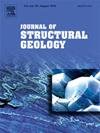断层控制的石膏脉网:来自西班牙南部活动galera断层的启示
IF 2.9
2区 地球科学
Q2 GEOSCIENCES, MULTIDISCIPLINARY
引用次数: 0
摘要
岩脉可以帮助我们了解它们形成的应变条件、压裂的时间和顺序,以及产生水泥的流体的性质。断裂带内强烈的压裂作用促进了矿脉的形成,但断裂对矿脉形成的控制程度、矿脉的类型及其发育等仍是一个悬而未决的问题。本文分析了西班牙南部Galera断裂对上更新世和更新世岩石中石膏脉网的形成、分布和演化的影响。野外填图和构造分析表明,矿脉集中在断层破坏带内,其空间分布受断层几何形状、运动学特征和寄主岩性横向连续性的控制。18个地点的构造分析表明,脉体走向与构造构造有关。断层附近的矿脉表现出有组织、一致的走向,而离断层较远的矿脉则表现出更多变的走向。脉走向对由断层和附属构造的几何、运动学和相互作用决定的局部应变高度敏感。此外,在断层附近,矿脉长度趋于增加。矿脉强度和密度受矿脉长度、矿脉方向和矿脉承载层厚度的控制。此外,脉体形成于沉积物沉积后不久,在最小的静岩载荷下形成,可能是由断层相关应变驱动的。这一早期地层受锥中锥等微结构和构造倾斜导致的早期脉体旋转的支持。综上所述,构造对脉体的形成、演化、分布和属性具有强烈的影响。本文章由计算机程序翻译,如有差异,请以英文原文为准。
FAULT-CONTROLLED GYPSUM VEIN NETWORKS: INSIGHTS FROM THE ACTIVE GALERA FAULT, SOUTHERN SPAIN
Veins provide insights into the strain conditions under which they formed, the timing and sequence of fracturing, and the nature of the fluids from which their cement precipitated. Intense fracturing within fault zones promotes vein formation, but there are still open questions about the extent of fault control on vein formation, the type of veins and their development. This study analyses the influence of an active strike-slip fault —the Galera Fault, Southern Spain— on the formation, distribution, and evolution of gypsum vein networks hosted in Pliocene and Pleistocene rocks. Field mapping and structural analysis reveal veins are concentrated within the fault damage zone, with their spatial distribution being controlled by fault geometry, kinematics, and the lateral continuity of host lithologies. Structural analysis at 18 sites indicates that vein orientation correlates with tectonic structures. Veins near faults exhibit organized, consistent strikes, while those farther away show more variable orientations. Vein strike is highly sensitive to the local strain defined by the geometry, kinematics, and interactions of faults and subsidiary structures. Additionally, vein length tends to increase near faults. Vein intensity and density are controlled by vein length and orientation, and the thickness of vein-hosting beds. Moreover, veins formed shortly after sediment deposition under minimal lithostatic load, likely driven by fault-related strain. This early formation is supported by microstructures such as cone-in-cone and the rotation of early veins due to tectonic tilting. In conclusion, this research highlights the strong tectonic influence on vein formation, evolution, distribution, and attributes.
求助全文
通过发布文献求助,成功后即可免费获取论文全文。
去求助
来源期刊

Journal of Structural Geology
地学-地球科学综合
CiteScore
6.00
自引率
19.40%
发文量
192
审稿时长
15.7 weeks
期刊介绍:
The Journal of Structural Geology publishes process-oriented investigations about structural geology using appropriate combinations of analog and digital field data, seismic reflection data, satellite-derived data, geometric analysis, kinematic analysis, laboratory experiments, computer visualizations, and analogue or numerical modelling on all scales. Contributions are encouraged to draw perspectives from rheology, rock mechanics, geophysics,metamorphism, sedimentology, petroleum geology, economic geology, geodynamics, planetary geology, tectonics and neotectonics to provide a more powerful understanding of deformation processes and systems. Given the visual nature of the discipline, supplementary materials that portray the data and analysis in 3-D or quasi 3-D manners, including the use of videos, and/or graphical abstracts can significantly strengthen the impact of contributions.
 求助内容:
求助内容: 应助结果提醒方式:
应助结果提醒方式:


